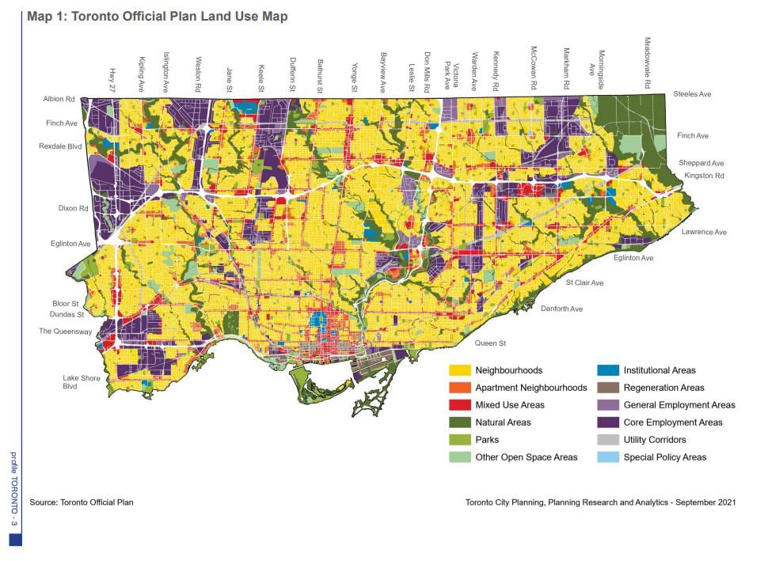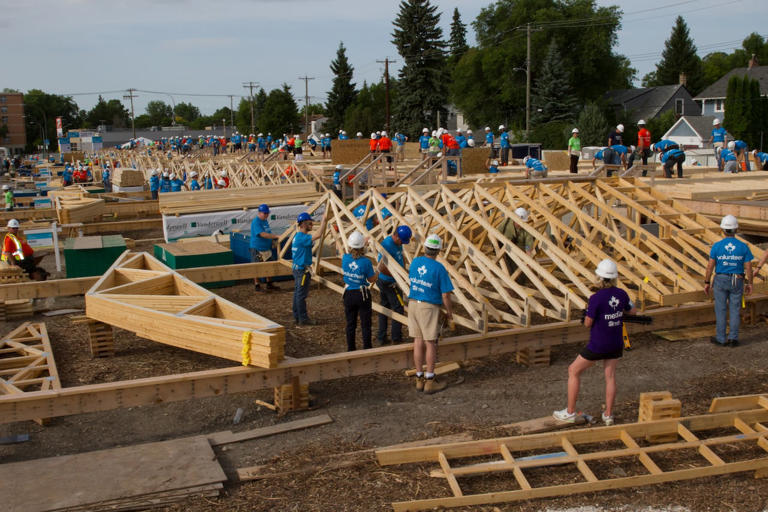Story by Vanessa Balintec • CBC - Thursday, July 19,2023
A housing crisis is well underway in Canada, and experts say the problem is only made worse by residents who oppose new housing developments.
While the sentiment, known commonly as Not In My Backyard (NIMBY), existed long before the housing shortage became pronounced, experts say counteracting it is more important now than ever before.
Why does Nimbyism exist?
Residents passionate about their communities want to have a say in what gets built and where, said Geoff Kettel, the president of the Federation of Urban Neighbourhoods, an Ontariowide coalition of resident associations.
Concerns range from a condo development casting shadows on existing properties to whether or not local hospitals, schools and other services can keep up with growth in the local population, he said. But voicing them, often through public consultations, comes with the risk of being labelled a NIMBY, which Kettel called "pejorative."
"We're regular citizens," said Kettel. "Everybody has the right to express themselves and to be part of the community."
Resident associations don't want to stop development altogether, Kettel said, adding many want to help "moderate" growth and encourage new projects to be in line with local neighbourhood character.
NIMBY sentiment is particularly directed toward affordable housing projects proposed in existing neighbourhoods, according to the Canada Mortgage and Housing Corporation (CMHC).
Leslie Evans, executive director of the Federation of Calgary Communities, an umbrella organization of more than 100 community associations, says affordable housing developments often stir fears of increased crime rates and lower property values among locals, which aren't proven to be true.
And while there will always be people who are "stuck" with NIMBY views, they're a minority, she said, adding that most residents often become more open to development after learning how it benefits the community.
"Labelling them NIMBY is a good way to dismiss people that may or may not have legitimate concern," said Evans.
"Lots of that is they don't necessarily understand what it is and how to build great communities. To build great communities, we need diversity of people and housing."
How prevalent is the problem?
Jim Dunn, director of independent academic network the Canadian Housing Evidence Collaborative, says it's hard to quantify the number of potential housing units that could have been built but weren't because of NIMBY sentiment.
But people can look at municipal land use maps for a sense of how neighbourhoods have been allowed to develop over time, Dunn said, pointing to Toronto's "yellowbelt."
Huge swaths of the city's residential areas, shown in yellow, were historically zoned strictly for single-detached or semi-detached homes. That changed this year after city council voted to allow the development of two, three and four-unit multiplexes throughout.
"A huge part of Nimbyism was actually enshrined in zoning legislation," said Dunn, adding that local politicians are put in a "bind" having to choose between supporting outraged constituents and increasing housing supply.

Areas shaded in yellow on the City of Toronto's land use map signify land slated for residential use. These areas were historically designated for single-family, detached home development until recent months when multiplexes became permitted citywide. (City of Toronto Official Plan)© Provided by cbc.ca
Recent data shows people are feeling and seeing the effects of NIMBY legislation and sentiment.
According to a November survey commissioned by non-profit Habitat for Humanity Canada, 54 per cent of Canadians feel that NIMBY sentiment is one of the main barriers to making affordable housing available in neighbourhoods, with almost three in four agreeing that people worry about the impact of affordable housing on their property values and neighbourhood.
"It's actually a really big problem, and it's a problem in every Canadian community," said Julia Deans, the non-profit's president and CEO. Habitat for Humanity Canada helps low-income families access affordable housing.
Kevin Lee, the CEO of the Canadian Home Builders' Association, said despite existing "appetite" to build more within existing neighbourhoods, Nimbyism discourages developers from trying to build. In many cases, local opposition to housing developments can "delay and sometimes completely derail projects."
"You're going to have so much opposition that it's just ... not worth the effort," said Lee.
Who is the problem affecting?
CMHC says some Canadians don't have the means of accessing the housing market, which is particularly more common in certain groups, such as people with disabilities. The latest data from the federal government shows more than 250,000 people are on affordable housing waiting lists across the country.
Peter Waldkirch, a director of housing advocacy group Abundant Housing Vancouver, says that the people who are hurt the most and pushed out because of Nimbyism are those without "power" in society, such as low-income earners, immigrants and young people.
In contrast, he said, those with NIMBY views often have more wealth, power and resources to advocate for their wants compared to the general population and those looking to move into affordable housing developments.
But their advocacy may be helping drive the very same system emptying their neighbourhoods and businesses and keeping their children and grandchildren from becoming homeowners, he said.
"I think a lot of NIMBYs don't realize the harm they are causing."
CMHC has said at the current pace of construction, Canada is still short on housing supply. It projects almost 2.3 million housing units will be added to the market by 2030, bringing the country's total housing stock to 19 million — but that's 3.5 million units short of achieving "housing affordability for everyone living in Canada."
And when housing does get built, Waldkirch said it's further from cities and their cores and into the "least desirable parts," far from jobs and amenities, impacting the community in ways beyond housing.
"It's bad for affordability, it's bad for environment and it's bad for the economy," said Waldkirch.
How do we counteract it?
Deans says Habitat for Humanity has leveraged different methods to get communities on board with affordable housing projects.
In Calgary, the local chapter has sent personalized letters from families moving into new affordable housing buildings to local residents, she said. In Winnipeg branch conducts door-to-door canvassing, public meetings with local residents and councillors and invites neighbours to help build the very housing units incoming families will inhabit.
"That gives them an investment in that home, too," said Deans. "Sometimes communities need a reminder of what their priorities might be."

Volunteer builders with Habitat for Humanity Canada help construct community houses through the Jimmy & Rosalynn Carter Work Project in Winnipeg in 2017.
(Submitted by Habitat for Humanity Canada)
Dunn says the rise of pro-housing groups and the relaxing of local land zone restrictions may be a sign NIMBY sentiment is becoming less common. But to keep the momentum going, he suggests giving people less "recourse" in legislation to oppose developments and making it easier to finance and build new developments, like Toronto multiplexes.
"There will be improvement, but there's still some obstacles to overcome," said Dunn.
That's why Waldkirch says it's important for neighbours who say "yes" to development to publicly support new housing projects. This is especially the case for renters and young people, who he said have been "extremely under-represented" in municipal elections and in housing planning processes.
"Get engaged. Show up and say 'yes' to housing," said Waldkirch.
"It's easy for people to show up and say 'no' to housing, and that's how it's been for decades."
Lee says at this point in the housing shortage, more housing units of all types are needed everywhere, not just in certain places, adding that's why builders, municipalities and provinces need to commit to reducing Nimbyism and "build smartly upwards, inwards and outwards."
"It's definitely not about building a whole bunch of towers. It's not about building a whole ton of single family homes as far as the eye can see either," said Lee.
"It's finding that happy balance."
Dunn says the rise of pro-housing groups and the relaxing of local land zone restrictions may be a sign NIMBY sentiment is becoming less common. But to keep the momentum going, he suggests giving people less "recourse" in legislation to oppose developments and making it easier to finance and build new developments, like Toronto multiplexes.
"There will be improvement, but there's still some obstacles to overcome," said Dunn.
That's why Waldkirch says it's important for neighbours who say "yes" to development to publicly support new housing projects. This is especially the case for renters and young people, who he said have been "extremely under-represented" in municipal elections and in housing planning processes.
"Get engaged. Show up and say 'yes' to housing," said Waldkirch.
"It's easy for people to show up and say 'no' to housing, and that's how it's been for decades."
Lee says at this point in the housing shortage, more housing units of all types are needed everywhere, not just in certain places, adding that's why builders, municipalities and provinces need to commit to reducing Nimbyism and "build smartly upwards, inwards and outwards."
"It's definitely not about building a whole bunch of towers. It's not about building a whole ton of single family homes as far as the eye can see either," said Lee.
"It's finding that happy balance."
No comments:
Post a Comment